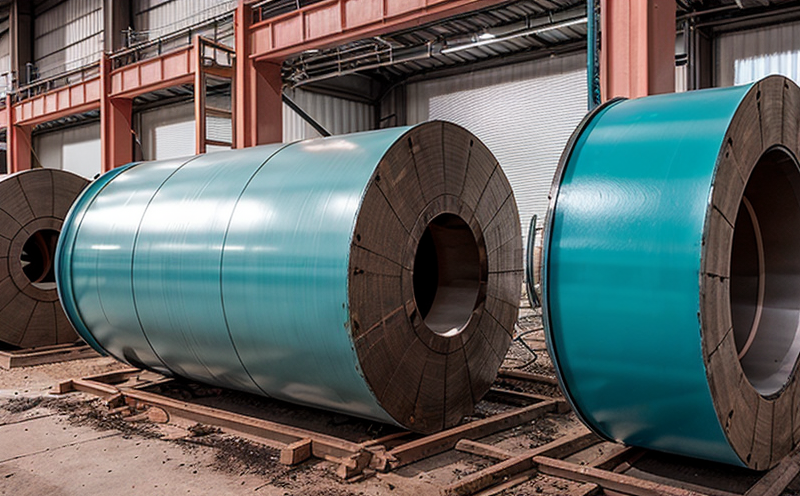ASTM G56 UV and Condensation Durability Testing
The ASTM G56 standard is a critical protocol used to evaluate the durability of materials, especially those utilized in industrial manufacturing processes. This testing method assesses how various materials withstand exposure to ultraviolet (UV) light and moisture condensation over an extended period.
The primary purpose of ASTM G56 UV and Condensation Durability Testing is to simulate environmental conditions that can lead to degradation or corrosion, thereby ensuring the reliability and longevity of materials in industrial applications. This testing method is particularly useful for products intended for use outdoors where they are exposed to direct sunlight and moisture.
The test involves exposing samples under controlled conditions that mimic natural weathering factors. The specimens are placed inside a specialized chamber equipped with UV lamps, which emit high-intensity ultraviolet light similar to the sun's rays. Additionally, this chamber is designed to create condensation by raising the humidity levels above 100% relative humidity (RH). This combination of UV radiation and moisture exposure accelerates aging processes that would normally take place over many years.
Specimen preparation plays a crucial role in ASTM G56 testing. Samples must be cut into standard sizes suitable for placement within the test chamber, typically 10 cm x 10 cm pieces. These samples should also undergo conditioning to ensure they are representative of their intended use environment before being subjected to accelerated weathering conditions.
Once prepared, specimens are mounted horizontally inside the testing chamber ensuring maximum exposure surface area is accessible to both UV radiation and condensation. The duration of this test varies based on specific requirements but usually lasts between 100-400 hours depending upon initial material properties and desired confidence levels associated with results.
The acceptance criteria for ASTM G56 tests are defined by the performance metrics measured throughout the experiment. Key indicators include changes in coloration, loss of glossiness, cracking or flaking of the coating layer, reduction in mechanical strength, and other observable physical alterations indicative of material degradation due to UV exposure combined with moisture condensation.
Understanding these aspects helps quality managers, compliance officers, R&D engineers, and procurement teams make informed decisions about selecting appropriate materials for industrial manufacturing processes. By adhering to standards like ASTM G56, manufacturers can ensure their products meet stringent durability requirements while minimizing risks associated with premature failure or non-compliance issues.
When selecting a laboratory capable of performing ASTM G56 UV and Condensation Durability Testing, it is essential to choose one with extensive experience in this specific type of testing. Eurolab offers comprehensive services tailored specifically towards meeting these needs using state-of-the-art facilities equipped with advanced equipment capable of delivering precise results.
Eurolab Advantages
At Eurolab, we pride ourselves on providing high-quality ASTM G56 UV and Condensation Durability Testing services that meet or exceed industry standards. Our team of experienced professionals ensures accurate data collection during all phases of testing, from sample preparation to final analysis.
- Accurate Data Collection: Eurolab utilizes cutting-edge technology and methodologies to ensure precise measurements throughout each stage of the test process.
- Comprehensive Reporting: Our reports include detailed information on how your materials performed under UV and condensation exposure, along with recommendations for improvement if necessary.
- Expertise in Industrial Applications: With years of experience working with various industries, Eurolab understands the unique challenges faced by industrial manufacturers when it comes to selecting durable materials.
- State-of-the-Art Facilities: Equipped with the latest equipment and technology, our laboratories provide an environment conducive to producing reliable results.
We take pride in our ability to deliver consistent, high-quality results across all types of materials tested. Whether you're looking for basic compliance testing or detailed performance evaluations, Eurolab has the expertise and resources needed to meet your specific requirements.
International Acceptance and Recognition
The ASTM G56 UV and Condensation Durability Testing standard enjoys widespread acceptance internationally among manufacturers of materials intended for use in harsh environmental conditions. Many countries recognize this test as a key component in ensuring product quality before they are released into the marketplace.
For instance, many international regulatory bodies such as the International Electrotechnical Commission (IEC), European Committee for Standardization (CEN), and others have incorporated ASTM G56 into their own standards or guidelines. This means that compliance with this test can often be seen as a prerequisite for meeting broader regional requirements.
Additionally, numerous companies across different sectors rely on ASTM G56 UV and Condensation Durability Testing when developing new products or evaluating existing ones. By adhering to these globally recognized practices, businesses demonstrate their commitment to producing reliable materials that stand up well against environmental stresses.
The international acceptance of ASTM G56 highlights its importance within the broader framework of quality assurance efforts. It serves not only as a valuable tool for manufacturers but also strengthens trust between buyers and sellers by providing consistent benchmarks against which performance can be measured.
Environmental and Sustainability Contributions
- Promoting Sustainable Practices: By identifying materials that perform well under UV and condensation exposure, manufacturers can reduce waste associated with premature failures or replacements. This contributes positively towards reducing the environmental impact of industrial processes.
- Resource Efficiency: Selecting durable materials reduces resource consumption over time since less frequent replacements are required. This leads to more efficient use of raw materials and energy throughout product lifecycles.
- Emissions Reduction: Longer-lasting products mean fewer manufacturing cycles needed, which translates into lower greenhouse gas emissions from production activities.
- Promoting Circular Economy: Materials that withstand harsh conditions promote a more circular economy by extending their useful life and reducing the need for disposal or recycling of short-lived items.
Incorporating ASTM G56 UV and Condensation Durability Testing into product development processes helps drive positive changes towards sustainability goals. Manufacturers who prioritize durability through rigorous testing contribute significantly to creating a more sustainable future while enhancing their competitive edge in global markets.





